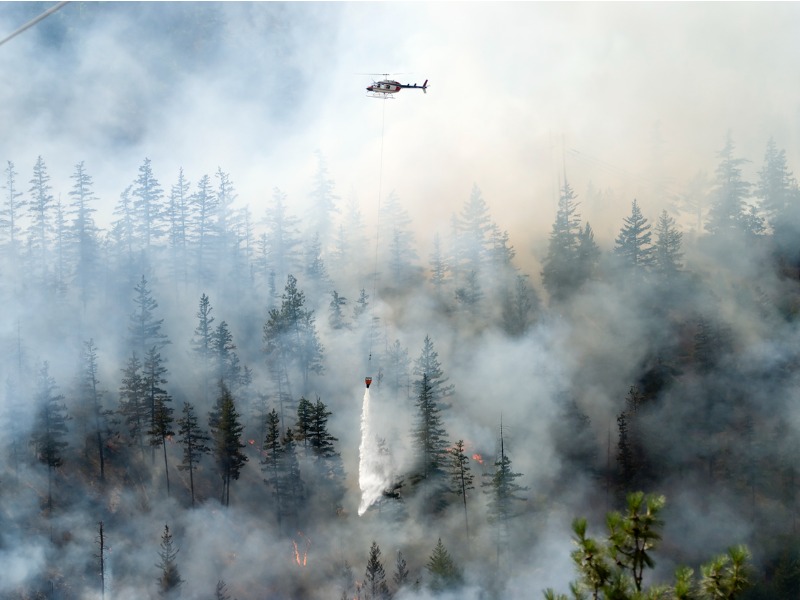How Canada’s wildfire season will shape reinsurance renewals

Reinsurers have their ears to the ground on climate change losses, and Canada’s record wildfire season is adding to the heat, according to industry experts.
But while reinsurers are keeping a close watch on wildfire risk, tallied wildfire losses aren’t expected to raise reinsurance renewals for Canadian carriers exponentially, experts told Canadian Underwriter.
Part of that is because insurers were bearing higher retentions during the loss period — a product of the decreased reinsurance capacity on Jan 1. 2023 renewals, where rates skyrocketed and insurers carried more risk.
“The increased retentions on Cat programs this year really meant that more losses were retained by the carriers and less was passed on to reinsurance,” Jeff Turner, partner and managing director, Toronto, at Acrisure Re told CU.
“I don’t think insurers need to be prepared for a wholesale change from the reinsurers in terms of how they’re evaluating wildfire risk.”
That said, when wildfire smoke descended south of the border this summer, it raised global awareness. Reinsurers, who were already wary about the impact of climate change on insured losses, happened to take note.
“There’s certainly heightened interest from the global reinsurers to understand what’s happening with climate change losses, and Canada is just simply part of that,” Matt Wolfe, Aon Canada’s president and CEO of Reinsurance Solutions said. “Our wildfires are just part of the larger global concern.”
In fact, wildfires might be edging out typical ‘primary’ perils, in terms of reinsurers’ concern levels.
“Their attention has expanded beyond so-called peak perils such as earthquake or hurricanes into other events, with wildfire being a prominent concern,” Wolfe added.
Although it’s possible some losses are still being counted, fires in Yellowknife and Hay River, N.W.T, Okanagan and Shuswap, B.C., and Tantallon, N.S., collectively tallied over $945 million in insured losses, according to Catastrophe Indices and Quantification Inc.
It’s no surprise reinsurers are closely monitoring how climate change will drive frequency and severity of natural disasters.
Since 1880, average global temperatures have increased by about 1 degree Celsius. And for every degree of warming, the number of lightning strikes goes up by about 12%. In a typical year, lightning causes more than half of the wildfires in Canada.
This year, B.C.’s wildfire service said the majority of the province’s fires — approximately 71% — have been sparked by lightning, proving a direct correlation between warming temperatures and increased wildfires.
“Wildfires are really good evidence of climate change, and the uncertainty that it brings in general,” said Turner. “This year was a record for wildfires, but next year it could be something else.
“It’s a reminder that all the secondary perils — flood, hail, wildfires — are really not so secondary. They’re a very material threat in the Canadian insurance space, and they need to be carefully considered,” he added.
Wildfires in Canada have historically been extremely costly for global reinsurers.
About 85% of the insured losses from Canada’s costliest loss event, the 2016 Fort McMurray wildfire, were covered by reinsurance and most of that was covered by European reinsurers, according to previous Canadian Underwriter reporting.
That said, carriers may feel more pressure to justify how they’re evaluating, and mitigating, risk in the new year.
Though renewals won’t be nearly as competitive as last year, carriers should be prepared to prove they are a good risk to their reinsurers.
“It can be very difficult for carriers to monitor their exposures to active events, and to make sure they aren’t writing new business near active wildfire areas,” said Turner.
That’s why it’s important for carriers to convey an understanding of their risk, as well as the steps they’ll take if a disaster occurs.
“Cedents will certainly want to have a wildfire strategy in place and be able to articulate that to reinsurers,” Turner said.
“Carriers need to be taking appropriate precautions to measure, manage and charge for the risk. Likewise, reinsurers will expect to be able to get sufficient data and information from their cedents to be able to analyze and do the same on their end.”
Feature image by iStock.com/Mooneydriver







